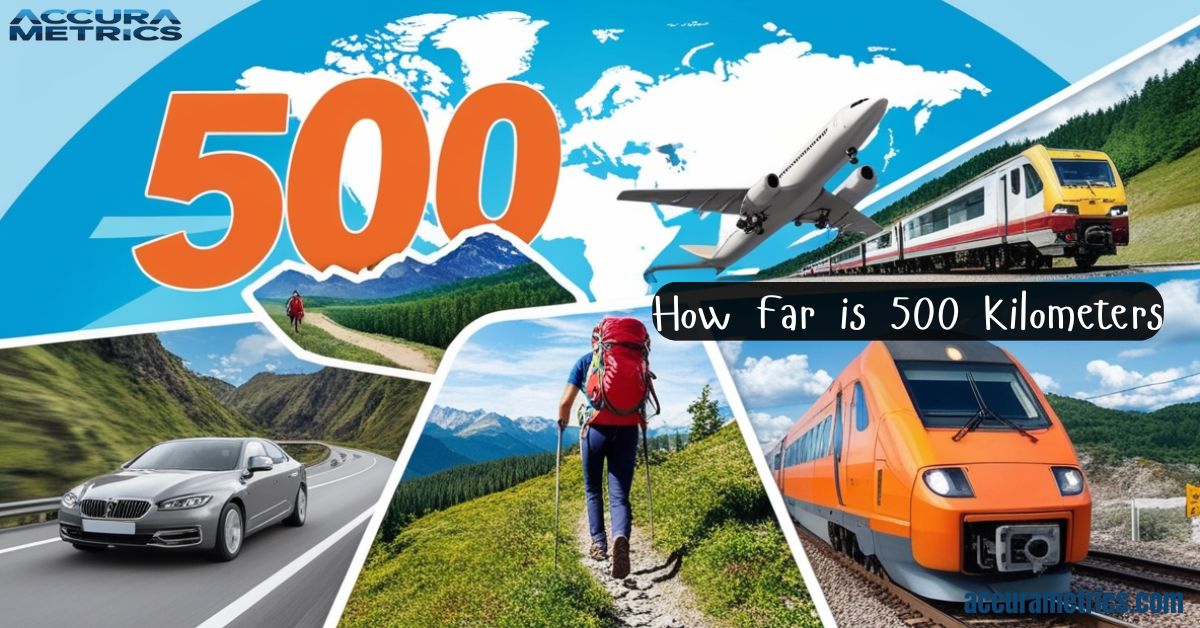Ever wondered how far 500 km really is? It’s a distance seen in road trips, hikes, and flight plans, but it can be tricky to grasp.
Fear not! We are about to embark on a mind-bending adventure that’ll make long distances as familiar as your favorite pair of sneakers. Buckle up, lace those boots, or spread your wings. We are diving deep into the world of distance
1. The Kilometer Conundrum

Before we jet off, let’s get our bearings. A kilometer is 1,000 meters, or about 0.62 miles for our imperial friends. So when we talk about 500 kilometers, we’re looking at roughly 310.6 miles.
It’s a distance that’s long enough to be impressive, yet short enough to tackle in a day’s drive. But numbers alone don’t paint the full picture. Let’s explore why 500 km matters in our daily lives and how it shapes our world.
2. The 500 km Road Trip
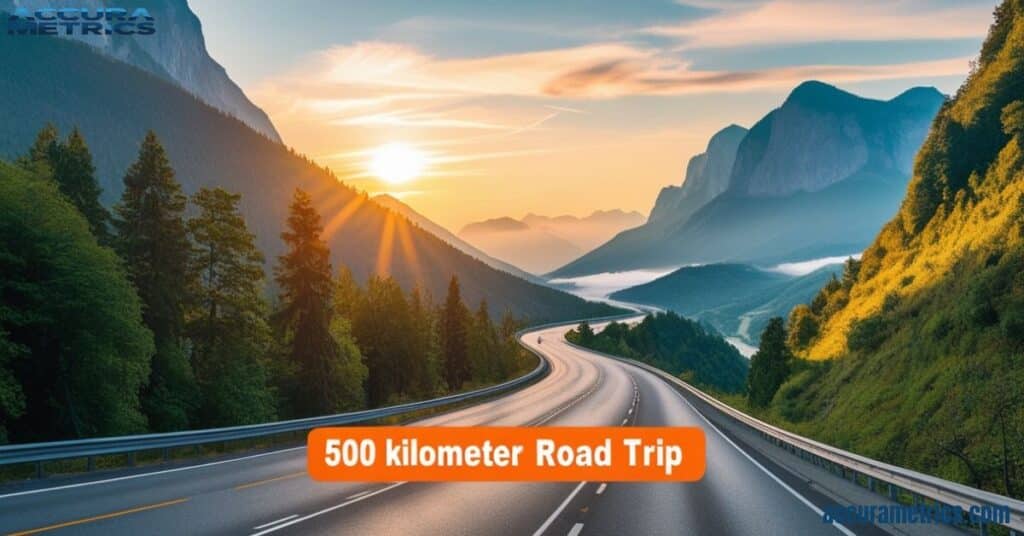
Fear not! We are about to embark on a mind-bending adventure that’ll make long distances as familiar as your favorite pair of sneakers. Buckle up, lace those boots, or spread your wings. We are diving deep into the world of distance
Time on the Clock
Driving 500 kilometers takes time. Here’s what the journey might look like.
- On highways with a 100 km/h speed limit: About 5 hours of pure driving
- Factoring in breaks, traffic, and slower zones: 6-7 hours is more realistic
“A journey of a thousand miles begins with a single step, but a journey of 500 kilometers begins with a full tank of gas and a great playlist!” – Road Trip Wisdom
Fuel Costs
Next, let’s talk about fuel costs. Here’s how distance can impact your wallet depending on your vehicle. Here’s a quick breakdown:
| Vehicle Type | Approximate Fuel Consumption (500 km) |
|---|---|
| Compact Car | 30-35 liters |
| SUV | 45-50 liters |
| Electric Car | 100-125 kWh |
Curious about measurements? Check out our article on “10 Things That Are 500 Meters Long or Big”
Road Trip Examples
500 kilometers road trip examples that’ll get your wheels turning:
- Paris to Amsterdam: A journey through history and culture
- New York City to Washington D.C. (and back): Politics, pretzels, and everything in between
- Tokyo to Osaka: Bullet trains and breathtaking landscapes
3. The 500 km Walk
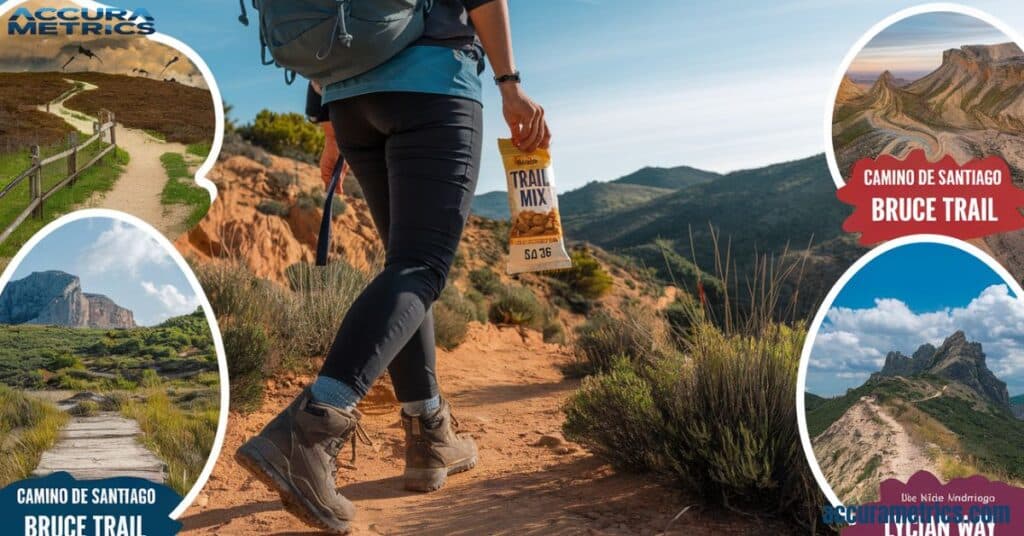
Ready for a long hike? Walking 500 km isn’t easy, but it’s an adventure.
Time and Effort
- Average walking speed: 5 km/h
- 500 km walking time (non-stop): 100 hours
- Realistic scenario (8 hours/day): 12-13 days
Calorie Burn
Prepare to burn some serious energy:
- Average person (70 kg): Burns about 300 calories per hour of walking
- Total calorie burn for 500 km: A whopping 30,000 calories!
That’s equivalent to about 111 Big Macs. But maybe stick to trail mix and protein bars for this journey!
Famous 500 km Trails
For the adventure seekers, here are some epic trails that clock in around our magic number:
- Camino de Santiago (French Way): 780 km of spiritual enlightenment
- Bruce Trail, Canada: 890 km of Canadian wilderness
- Lycian Way, Turkey: 540 km of ancient history and Mediterranean beauty
4. 500 kilometers in Nature

Nature showcases 500 km in incredible ways.
The Nile River
The mighty Nile stretches for 6,650 km. Our 500 km journey is just a small fraction of this legendary waterway that shaped civilizations.
The Amazon Rainforest
Imagine hiking through the thickest, most diverse forest on Earth. That’s about how wide the Amazon Rainforest is in some places!
“In nature, nothing is perfect and everything is perfect. Trees can be contorted, bent in weird ways, and they’re still beautiful.” – Alice Walker
The Great Barrier Reef
The world’s largest coral reef system spans about 2,300 km, and our distance would cover a significant portion of this underwater marvel.
Read Amazing Insights “The History of Length Measurements“
5. City Comparisons
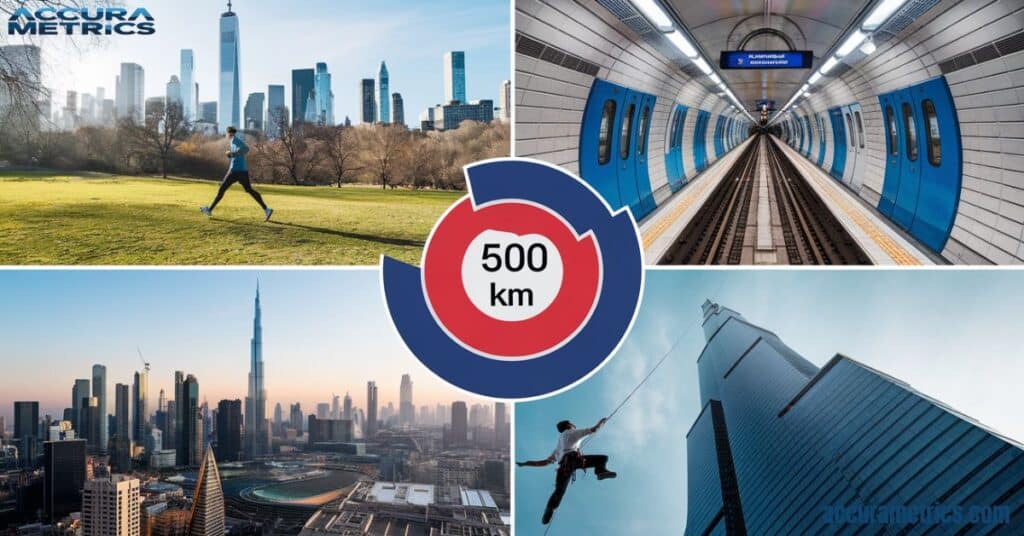
Now, let’s explore this distance in urban terms, beginning with Central Park.
125 Laps Around Central Park
New York’s iconic green space has a 6.1 km loop. You’d need to circle it 125 times to hit 500 km. That’s a lot of hot dog stands!
50 London Underground Trips
The longest continuous journey on the Tube is about 54 km. Imagine making that trip 50 times.
83 Burj Khalifa Climbs
At 828 meters tall, you’d need to scale the world’s tallest building 83 times to reach 500 km vertically. Hope you’re not afraid of heights!
6. 500 km in History
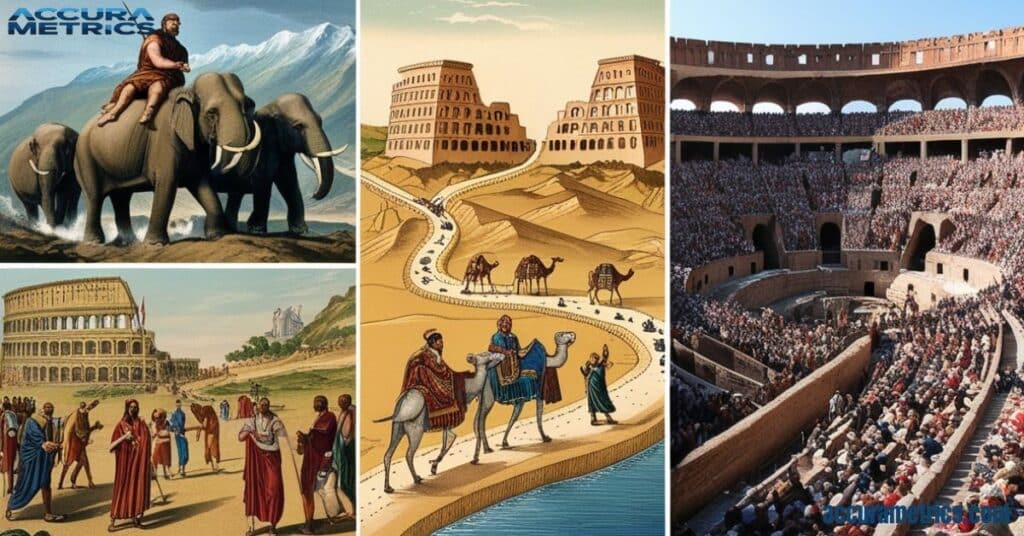
History buffs, this one’s for you. Let’s see how 500 km stacks up against some legendary journeys.
Hannibal’s Alpine Trek
When Hannibal crossed the Alps with his elephants, he covered about 500 km of treacherous mountain terrain. Imagine doing that with a herd of pachyderms.
The Silk Road
The main route of the ancient Silk Road spanned about 6,437 km. Our 500 km journey would cover roughly 1/13 of this historical trade route.
Roman Stadiums
A Roman stadium was about 185 meters long. Line up 6,250 of them, and you’ve got yourself 500 km of ancient athletic glory!
7. 500 km in Sports

For the sports enthusiasts, here’s how 500 km measures up in the world of athletics.
Tour de France Comparison
The longest single stage in recent Tour de France history was about 248 km. Our 500 km would be like doing that grueling ride almost 12 times!
Olympic Pool Laps
An Olympic pool is 50 meters long. Swim 5,000 laps, and you’ve covered our 500 km. Michael Phelps, eat your heart out!
NFL Field Runs
An NFL field is 100 yards (91.44 meters) long. Run from end zone to end zone 1,250 times, and you’ve hit our magic number.
Discover More “18 Everyday Items That Are 5 Meters Long/Big“
8. 500 km in the Air

Taking it to the skies, let’s see how 500 km compares in the air.
Commercial Flights
- Flight distance 500 km: About 1 hour in the air
- Fuel usage: Approximately 2,000-3,000 kg for a medium-sized passenger jet
The Space Station
The ISS orbits Earth at about 7.66 km/s. It would cover 500 km in just over a minute!
Concorde Comparison
The legendary Concorde cruised at about 18.3 km altitude. Stack that height 46 times, and you’ve reached our 500 km mark vertically.
Case Study: The 500 km Challenge

Objective: This case study examines the experiences of a group of friends traveling 500 km across Europe, highlighting the differences in time, environmental impact, and cultural experiences between car, train, and walking.
Background Context: The friends, all avid travelers, decided to test their endurance and explore the cultural richness of Europe. They aimed to experience how different modes of transportation could alter their journey while covering the same distance.
The Journey:
- Driving 500 kilometers:
- Route: Paris to Amsterdam
- Time: 6 hours (including one 30-minute break)
- Fuel Consumed: 35 liters (compact car)
- Experience: Driving through picturesque countryside, they enjoyed stunning views of vineyards and quaint villages, but the environmental impact weighed on their minds.
- Train Journey:
- Route: Vienna to Budapest to Belgrade
- Time: 8 hours (including transfers)
- Energy Efficiency: Significantly higher than driving
- Experience: The train offered a comfortable ride through historic cities, with opportunities to mingle with fellow travelers and savor local snacks.
- Walking 500 kilometers:
- Route: Section of the Camino de Santiago (Spain)
- Time: 13 days (walking 8 hours daily)
- Calories Burned: Approximately 30,000
- Experience: Walking allowed them to connect deeply with the landscape and culture, though it was physically demanding. One traveler remarked, “Walking the Camino was tough but allowed us to connect with the landscape and each other in a way that driving never could.”
Key Findings:
- Driving: Fastest but least environmentally friendly, with significant fuel consumption.
- Train: Efficient and comfortable, providing a lower carbon footprint and a chance to explore cities during transfers.
- Walking: Offered the richest cultural experience, fostering connections with nature and local people, but required significant time and physical endurance.
Visual Aids: (Include a map showing their route from Paris to Amsterdam, with marked stops along the way.)
Summary of Key Takeaways:
This distance comparison shows how various transport modes change the experience of traveling. Choosing between speed, environmental impact, and immersive experience depends on personal priorities. Whether you prefer the speed of a car, the comfort of a train, or the adventure of walking, each option offers a unique journey.
Explore Furthe “10 Common Things That Are 3 Inches Long”
FAQs
1. How many miles is 500 kilometers?
500 kilometers to miles is approximately 310.6 miles. This conversion is useful for travelers moving between metric and imperial systems.
2. How long does it take to drive 500 kilometers?
Driving 500 kilometers typically takes about 5-6 hours on highways, assuming an average speed of 100 km/h (62 mph). However, factoring in breaks and traffic, a more realistic estimate is 6-7 hours.
3. Can you walk 500 kilometers?
Yes, but it’s a significant undertaking. The 500 km walking time for an average person walking 8 hours a day at 5 km/h would be about 12-13 days. It’s equivalent to walking nearly 12 marathons.
4. How far can you fly in 500 kilometers?
A flight distance of this length is considered a short domestic flight, similar to the distance from Paris to Amsterdam or New York to Washington, D.C. Most commercial flights complete this journey in about one hour.
5. What’s a good way to visualize 500 kilometers?
For a natural comparison, this distance is about 1/8 the length of the Amazon River or 1/6 of the Danube River. In urban terms, it’s roughly 125 laps around Central Park in New York City or 74 trips along the Las Vegas Strip.
Read Amazing “Examples 10 Common Things That Are 15 Centimeters Long”
Conclusion: Understanding 500 km
We have journeyed through rivers, scaled skyscrapers, and even touched the edge of space – all to grasp the epic scale of 500 kilometers. From road trips to marathon runs, from historical expeditions to modern flights, this distance shapes our world in countless ways.
Whether you’re planning a 500 km journey by car, foot, or imagination, you now have a treasure trove of comparisons to bring this distance to life. So next time someone asks you, “How far is 500 kilometers?” you can regale them with tales of Amazonian treks, space station orbits, or simply how many laps it’d take around your local park.
Remember, distance is more than just a number – it’s a gateway to adventure, discovery, and a deeper understanding of our vast and varied world. So go ahead, plan that road trip, lace up those hiking boots, or simply let your mind wander across 500 kilometers of possibility. The journey awaits.
Quiz 500 km Knowledge
Ready to test your understanding of this epic distance? Take this quick quiz to see how well you grasp the concept.
1. How many miles are 500 kilometers?
a) 200 miles
b) 310.6 miles
c) 500 miles
d) 620 miles”
2. Question: How long does it take to drive 500 km on a highway (no stops)?
a) 3 hours
b) 5 hours
c) 8 hours
d) 10 hours
3. Which distance is closest to 500 km?
a) New York to Los Angeles
b) Paris to Amsterdam
c) London to Edinburgh
d) Tokyo to Beijing”
4. How many marathons equal 500 km?
a) 5
b) 8
c) 12
d) 20″
5. Walking 500 km at 5 km/h for 8 hours a day takes approximately:
a) 5 days
b) 8 days
c) 12-13 days
d) 20 days”
Answers:
- b) 310.6 miles
- b) 5 hours
- b) Paris to Amsterdam
- c) 12
- c) 12-13 days
How did you do? Whether you aced it or learned something new, you’re now better equipped to understand and appreciate the epic scale of 500 kilometers.
Interactive Element: “Plan Your Own 500 km Adventure”
Ready to make 500 km your own? Here are some tools to get you started:
- Google Maps: Plan your own journey of this distance.
- Strava: Plan a multi-day hike or bike ride
- Flight radar websites: See what cities are within a 500 km radius of your location
Share Your 500 km Stories
We’d love to hear from you! Have you embarked on a 500 km adventure, or do you have your own unique comparisons to share? Whether it’s a memorable road trip, an epic hike, or interesting facts about distances, drop your stories and insights in the comments below. Your experiences could inspire others to explore the fascinating world of distance.
Read Amazing Wonders “10 Common Things That Are 400 Feet long”

My name is Linda, and I am an experienced blogger with a passion for precision and craftsmanship. With years of expertise, I contribute to Accura Matrics, bringing a wealth of knowledge and a keen eye for detail. My insightful articles and expert tips are designed to help readers achieve excellence in their measurements and dimensions projects, offering valuable guidance in the pursuit of accurate and thoughtful design.

